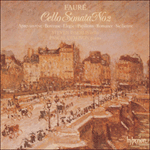‘Gerhardt and Licad sound as free as air, intellectually confident, full of verve, with niceties of balance and intensities never an issue; a convincing frame of colour, movement and sound in place for every movement, every piece’ (Gramophone)
‘Visionary performers … one has a powerful sense of Alban Gerhardt's compelling grasp of architecture’ (BBC Music Magazine)
‘Gerhardt and Licad make a particularly fine duo here, working emotionally in unison, sensing the music's contours with like mind, breathing as one’ (The Daily Telegraph)
‘Like the works themselves, Gerhardt's playing and that of the pianist Cecile Licad is full of subtleties, the half-tones and inflections that make the chamber music of Fauré's final decade so elusive and fragile’ (The Guardian)
‘An arrestingly beautiful survey … this repertoire has been explored frequently and by some of the best, but seldom more persuasively than here … from every standpoint, Gerhardt's accounts of the sonatas seem exceptional, with their assured technical mastery and uncanny depth of insight … magnificent cello playing from Gerhardt, empathetically supportive accompaniments from Licad and a wonderfully natural and atmospheric recording to boot … recommended’ (International Record Review)
‘Both cello sonatas are rolled out effortlessly and with an abundance of colour … other short cello works, the delicious Élégie included, pad out this sizeable, and very satisfying, offering … a super recording’ (The Scotsman)
‘Alban Gerhardt has arrived at the ideal marriage of Fauré's refinement, essential reticence and the passion that lies just beneath the surface of the two cello sonatas’ (Yorkshire Post)


 Fauré: Cello Sonata No 2 & other works
Fauré: Cello Sonata No 2 & other works
